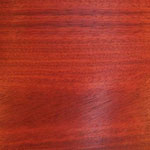Serving Upstate NY—VT—MA • For selections & prices, CALL or EMAIL US
Bloodwood (Muirapiranga)
Grades & Properties of Wood Flooring —
Exotic Species
Scientific Name:
Brosimum rubescens
Other Common Names and Related Species:
- Cardinal Wood
- Conduru
- Muirapiranga
- Satine Rouge
- Satine Rubane
- Satinjout
- South American Bloodwood
Shop online now for Bloodwood Flooring »
Origin:
South America (Brazil, Peru, French Guiana, Panama, Colombia, Suriname).
Janka Hardness: 2900
Bloodwood (or Muirapiranga) is a very hard wood flooring species. It is just over 124% harder than Red Oak, twice as hard as hard Maple, slightly over 59% harder than Hickory (or Pecan), nearly 51% harder than Jarrah, and just under one-third harder than Santos Mahogany's ranking of 2200.
Grades of Bloodwood Flooring:
Clear grade Bloodwood flooring is color-sorted for a rich consistent blood red color. Bloodwood is the most deeply red colored wood available and is the most popular in the Clear grade. Only the heartwood of the tree is used in the Clear grade. It is a deeper red than Santos Mahogany and Brazilian Cherry. An occasional small yellow streak may be present that is very prevalent in the sapwood of the tree. With Select and Better Bloodwood flooring, more yellow streaking will be present. With Rustic grade Bloodwood flooring, color varies dramatically from the deep reds to an almost white color in the sapwood.
Bloodwood Flooring Dimension Specifications:
Most Bloodwood flooring is milled in South America because it is more cost-effective to ship finished material than raw lumber. Lengths of the Bloodwood flooring bundles are 7 feet so they can easily fit into 8-foot-wide steel shipping containers. All pre-milled products are tongue-&-groove and end-matched (tongue-&-grooved on the ends of the boards). Moisture content ranges from 6% to 8% for quick acclimation. The average length of the flooring pieces is usually about 3 feet and ranges from 1 to 7 feet. Almost all imported flooring that is found is in 7-foot bundles, with widths available from 2¼″ to 5″. If a long or wide plank floor is desired, raw lumber must be obtained and the flooring must be milled here in the United States. Typically, the lengths can develop up to 12 feet. However, the cost can be double that of the pre-milled stock because of waste and labor costs in the United States. Also, raw lumber is relatively expensive because it is taxed more heavily than finished products to support local economies in South America.
Flooring Availability:
Bloodwood flooring is available in prefinished and unfinished solid for nail-down applications on a wood subfloor and sometimes in engineered form with a veneer top layer for application over concrete. Bloodwood is a peripheral species in comparison with Brazilian Cherry and Brazilian Walnut. Bloodwood has become increasingly scarce since 2007. There is a large amount of Bloodwood in South America, and it is not endangered. However, less logging, stricter regulations, and a slower American economy have all contributed to the rarity of this product in this country.
Finished Floor Appearance:
A Clear grade floor will have an even deep red appearance. Oil-based finishes allow Bloodwood to age to a deep brown color, unless lacquer or de-waxed shellac is first applied to help preserve the distinctive red color of the wood. Water-based finishes will preserve the natural color but may be slightly milky in appearance due to the dark red color of Bloodwood. Rustic or “Sap” Bloodwood will have extreme color variations similar to that of Rustic Hickory, with deep red and white tones.
Flooring Durability and Stability:
Bloodwood flooring is durable and resists denting and traffic wear quite well. It is more dimensionally stable than many North American floors because of its density. Bloodwood flooring is very heavy, weighing over 3 pounds per square foot.
Workability of Bloodwood Flooring:
Despite being hard and tough, Bloodwood works easily with both hand and power tools. When installing the Bloodwood flooring, it is best to use a manual nailer. Staples and pneumatic nailers tend to split the wood. It holds screws well, and it glues, stains, and polishes to a very attractive finish. It can be somewhat difficult to sand with flooring equipment because of its hardness. Professional sanding and finishing is recommended. This wood is very resistant to decay and insects; these resistant properties may contribute to a possible allergic response to the dust. To avoid a possible allergic reaction to the material, wear a dust mask and long-sleeve shirt when working with Bloodwood.
Principal Uses of Bloodwood Flooring:
Bloodwood flooring is used in high-end residential and commercial applications for a dramatically elegant floor. It is also used for color-contrasting borders and medallions.





